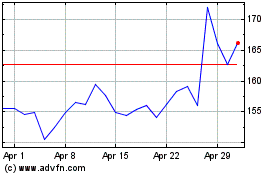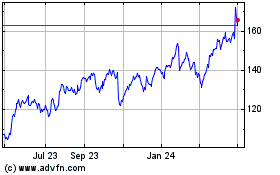By Catherine Stupp
Governments and companies are planning to introduce mobile
applications that use Bluetooth to track coronavirus infections.
Researchers say the technology keeps users' identifying data
private, but the complexity of working with Bluetooth raises
cybersecurity concerns.
Bluetooth, a widely used technology for connecting devices, has
emerged as the technology of choice for tracking the spread of the
coronavirus, as the U.S. and European countries decide how to
safely reopen businesses in the coming weeks and months. European
governments including France, the U.K. and Germany said in recent
weeks that they are developing Bluetooth-based mobile apps to
notify individuals who came close to someone who has the virus.
Singapore and Australia are already using Bluetooth-based
tracing apps. Apple Inc. and Alphabet Inc.'s Google said this month
they are working on a Bluetooth system that developers can use to
build tracing apps while protecting users' privacy.
Security and privacy researchers say there are advantages, along
with potential risks, to using Bluetooth. It reveals less detailed
information about a person's location than other technologies, such
as GPS. Bluetooth's specifications are several thousand pages long,
and that complexity can lead to mistakes by developers, said Ben
Seri, vice president for research at cybersecurity firm Armis
Inc.
In November, a researcher from the Technical University of
Darmstadt in Germany found a vulnerability in how Bluetooth was
implemented on devices using Google's Android operating system.
Google issued a patch in February. The problem could have allowed
hackers to launch remote cyberattacks.
In 2017, Mr. Seri discovered a security problem in how mobile
devices handled Bluetooth signals. Hackers could have exploited the
bug to move between devices using Bluetooth connections. Apple,
Google and other companies issued patches to fix the problem in
devices' operating systems. Such flaws are becoming less common as
companies improve how they implement Bluetooth, said Mr. Seri.
If many people start using tracing apps, there could be more
devices that enable Bluetooth all the time. Creative hackers might
look for devices with Bluetooth turned on in their vicinity and try
to launch remote cyberattacks, said Eliot Bendinelli, a
technologist at London-based nonprofit Privacy International.
Apple and Google have said app developers that use their
technology must comply with their privacy and security criteria.
For example, users must opt in to share their data. Public health
authorities would receive a list of Bluetooth beacons showing
devices that were in contact with users who have coronavirus.
The app that France plans to deploy by May 11 won't be able to
work on iPhones the way the government intended because Apple
appears to prevent the transfer of data collected by Bluetooth
coronavirus apps from a device to centralized servers, the
country's Digital Minister Cédric O told Bloomberg last week. He
said he asked Apple to change the policy.
Apple and Google declined to comment on France's complaint. A
Google spokesman referred to the two companies' publication last
week of updates to their system that they say will protect privacy
and make it more difficult to identify individuals. This includes
encrypting the Bluetooth metadata that phones share when they
connect using the technology.
Representatives of the companies said Wednesday their technology
will let public-health authorities assign users different risk
levels and tailor the notifications they send to people
accordingly. The risk level will be based on users' proximity and
duration of exposure to known coronavirus carriers, and will be
calculated on users' devices for privacy and security reasons.
Bluetooth connects devices by changing signals periodically to
hide users' unique addresses. The feature is designed to protect
privacy, but it could be possible for data to be exposed when a
mobile phone connects with other devices nearby, according to a
paper published last year by Boston University researchers.
It is unclear whether other apps installed on a phone could
collect data from a coronavirus tracing app, David Starobinski, a
Boston University professor in electrical and computer engineering
who wrote the research, said in an interview. The 2019 paper was
published before the coronavirus outbreak and didn't refer to
contact-tracing apps.
Individuals would be more secure using a second phone for
contact tracing, he said. "Ideally, we'd have a different device
that's more isolated from other services," he said.
Technical limitations
Aside from potential security risks, Bluetooth may not be a
perfect technology for tracing which people have come close enough
to transmit the coronavirus.
Developers of the original Bluetooth protocol said the
technology wasn't designed to generate detailed, reliable data
about proximity between devices. "The accuracy is limited," said
Sven Mattisson, one of the engineers who designed the concept for
Bluetooth in 1995 when he worked at Ericsson AB.
"You might interpret a false contact in a parking lot because
you get such a strong signal back, even though the contact is far
away. But if you're in an office space, you might not receive a
signal," said Mr. Mattisson, who is now an adjunct professor in
microelectronics at Lund University in Sweden. Signals might be
strong in an open space with few people even if they are far apart,
but they may be weaker in a crowded enclosed area.
A Bluetooth-based contact-tracing app that sends a signal when
two users are close to each other might not recognize when they are
separated by a window or walls, the Australian law firm Maddocks
wrote last week in a privacy assessment of the country's app. The
Australian health ministry said in response that it is seeking
advice about the use of Bluetooth from the country's cybersecurity
agency.
But the ubiquity of Bluetooth is an advantage amid a pandemic,
said Jaap Haartsen, who developed the technology with Mr.
Mattisson. It could take years to roll out mobile technology that
could be better suited to tracing contacts, he said. Mr. Haartsen
is now chief scientist for wireless technologies at Plantronics
Inc.'s Poly, a communications services company.
"It was not made for tracing, but at least it can give an
indication [of] which other phones have been in close range," he
said in an email.
Write to Catherine Stupp at Catherine.Stupp@wsj.com
(END) Dow Jones Newswires
April 30, 2020 05:44 ET (09:44 GMT)
Copyright (c) 2020 Dow Jones & Company, Inc.
Alphabet (NASDAQ:GOOGL)
Historical Stock Chart
From Oct 2024 to Nov 2024

Alphabet (NASDAQ:GOOGL)
Historical Stock Chart
From Nov 2023 to Nov 2024
